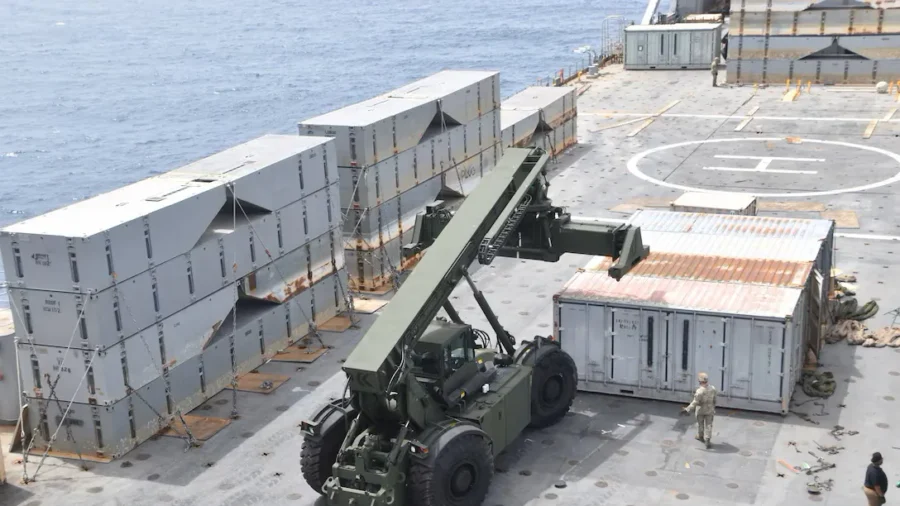U.S. Air Force Maj. Gen. Pat Ryder acknowledged, during a Tuesday Pentagon press briefing, that efforts to deliver humanitarian supplies to the Gaza Strip through a U.S.-backed temporary pier had met setbacks.
Maj. Gen. Ryder, the Pentagon press secretary, indicated he was unaware of any successful deliveries to Gaza’s civilian population in the days since trucks first began carrying those supplies off ships, over the pier, and into a marshaling area along the Gazan shoreline.
The Air Force general said about 569 metric tons of aid had come through the temporary pier since it began operating on May 17, and said, “very shortly I think you’ll see aid starting to be delivered.” A reporter asked Maj. Gen. Ryder to clarify his remarks, stating, “That hasn’t been delivered, right?” The Air Force general replied, “As of today I do not believe so.”
The Pentagon spokesman also acknowledged reports that some trucks carrying humanitarian supplies were “intercepted” after they left the marshaling area set up for the Mediterranean Sea delivery route.
“Some of that initial aid that was brought in, as it was being taken along a transportation route, was intercepted by some people who took that aid off those vehicles,” he said.
The U.S. military has coordinated the humanitarian aid pier effort, known as a Joint Logistics Over-The-Shore (JLOTS) operation, with Israeli counterparts. Pentagon officials have insisted there are no U.S. boots on the ground for the operation and that the Israel Defense Forces (IDF) are primarily responsible for the security of the operations on the shore.
A reporter asked Maj. Gen. Ryder to clarify the extent to which the IDF would oversee and provide security for the aid deliveries, stating she was under the impression the IDF’s responsibility over the humanitarian supplies extended from the marshaling area at least as far as secondary distribution warehouses further inside the Gaza Strip. The Pentagon spokesman replied with uncertainty, stating, “I’ll have to check on that.”
US Coordinating Alternative Delivery Routes: Pentagon
The U.S. effort to open the JLOTS aid pier comes amid concerns about growing famine conditions throughout the Gaza Strip following months of fighting. U.S. Agency for International Development (USAID) Administrator Samantha Power testified at an April 10 House hearing that nearly the entire population of the Gaza Strip “is living under the threat of famine” and indicated famine conditions had likely already begun in some areas.
Maj. Gen. Ryder said the U.S. military and its Israeli counterparts are discussing “alternative routes” to ensure humanitarian aid flows through the Gaza Strip, particularly after trucks were reportedly intercepted after leaving the marshaling area for the JLOTS pier.
The Pentagon spokesman said he is “fully appreciating” the desperation among those residing in the Gaza Strip, but also “fully appreciating the fact that it is very important that this aid get to the people who need it most.”
Traffic Levels Through Humanitarian Pier Unclear
Prior to anchoring the JLOTS pier to the Gazan shoreline, the Pentagon had told reporters that the pier would be able to handle around 90 truckloads of humanitarian supplies in its initial operating phase and expand to up to 150 truckloads of supplies later on.
Reporters repeatedly asked Maj. Gen. Ryder how many truckloads the pier has averaged since it first began handling deliveries onto the Gazan shoreline on May 17. He instead focused on the actual tonnage of supplies coming through the temporary pier.
“I would caution you around getting focused on the number of trucks that are going back and forth from [a logistics support vessel] to the shore, right? I mean, it’s a continuous circuit. So, the focus is on the amount of aid. The amount of trucks is irrelevant to the amount of aid that’s going to be delivered out into the communities,” he said.
Reporters at the Tuesday press briefing continued to note the disconnect between the Pentagon’s initial emphasis on the amount of trucks the JLOTS pier would be able to facilitate on a daily basis and Maj. Gen. Ryder’s new emphasis on the sheer tonnage of the deliveries. One reporter raised an objection that by now reporting the JLOTS pier had facilitated the flow of 569 metric tons of supplies onto the Gazan shoreline, rather than the number of trucks that handled those supplies, the Pentagon spokesman was making it difficult for members of the news media to understand whether the JLOTS pier was falling short or meeting the expectations the Pentagon had advertised for the operation.
“We’ll continue to keep you updated on this. I understand the intense interest in it, and we’ll continue to provide you as many statistics as we can,” Maj. Gen. Ryder said. “But again, looking at the forest through the trees here is about getting aid to the people of Gaza, and that’s what we’ll continue to focus on doing, no matter how many trucks are driving on or off the causeway.”
Other international actors have focused on truckloads of aid reaching the Gaza Strip as a metric for humanitarian conditions in the ongoing conflict. During her April 10 House testimony, Ms. Power said around 500 commercial and humanitarian trucks entered the Gaza Strip on average each day before the current fighting began.
The United Nations Relief and Works Agency for Palestine Refugees (UNRWA) has reported that some 5,671 aid trucks entered the Gaza Strip through land crossings in April, for a daily average of 189 trucks. UNRWA estimates that another 1,296 trucks arrived between May 1 and May 22, for a daily average of about 63 trucks this month.
Deputy Pentagon Press Secretary Sabrina Singh announced last month that it would cost about $320 million for the Gaza JLOTS pier to begin operating.

